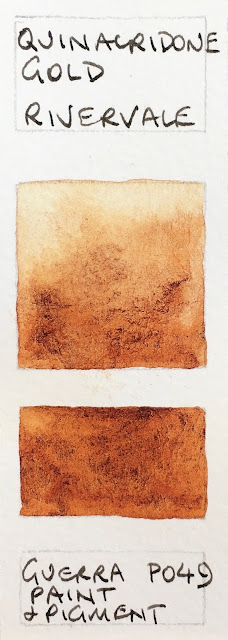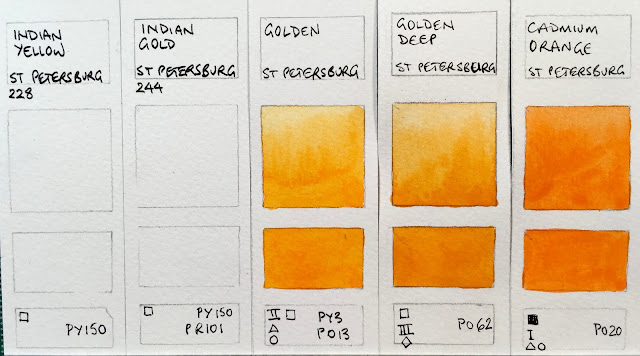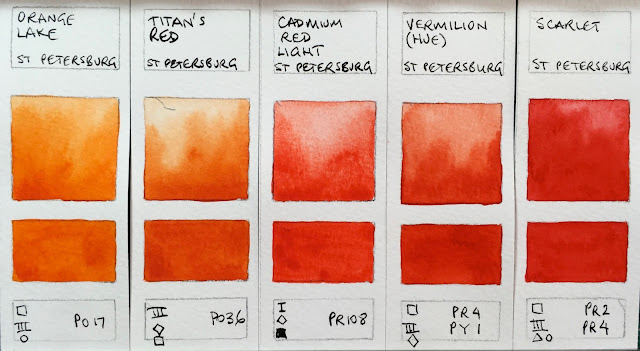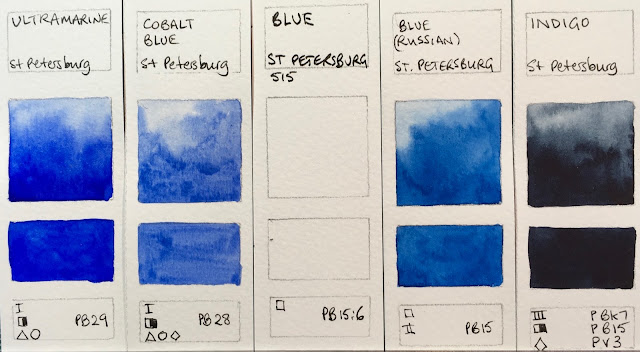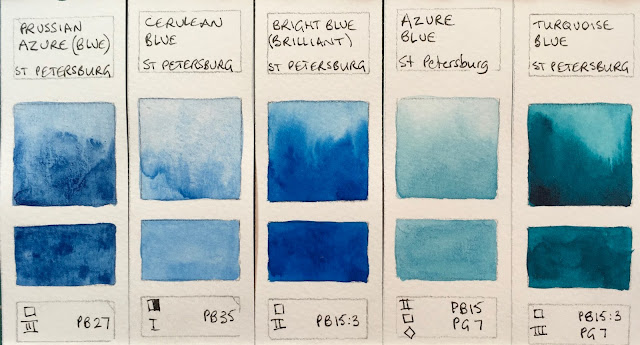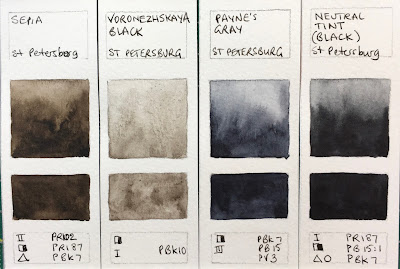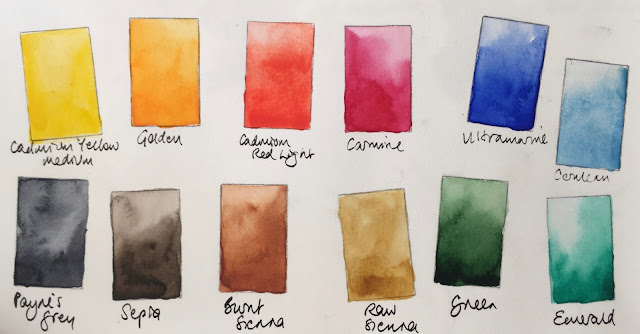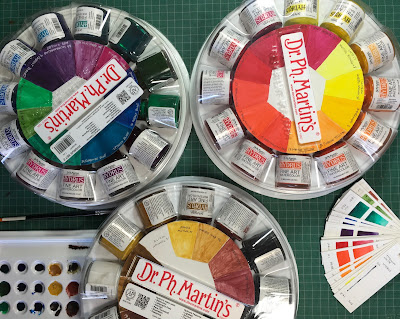Wallace Seymour, formerly Pip Seymour but now renamed after his partner Rebecca Wallace, are relatively new to the watercolour world, from the UK. For their Artists Watercolours range they focus on the very traditional pigments - they are largely cobalts, cadmiums, earth pigments and a couple of phthalos, rather than the newer quinacridones, pyrrols and perylenes. They are formulated with 'a special emulsion of honey and Kordofan Gum Arabic'. They are lovely to paint with - very beautiful with wonderful granulation.
They make a range of 20ml tubes colours called Vintage Watercolours which I will post about separately, but this is a completely different range of full pan colours called Artists' Watercolours that I will look at here. Unlike many brands, the tube colours are far from being the same pigments, names or handling characteristics as the pan colours.
There is also a set of 4 called The Four Humours, which I will show as a separate post here, and some other Ancient Drawing Materials that I haven't tried. Wallace Seymour also make Oils and acrylics but I haven't tried them at all.
The full pan Artists Watercolours are available in Australia from Pigment Lab in Newtown. I haven't tried all of them yet, but will show some here and update over time. They granulate beautifully and rewet with ease.
The full range of 58 Artists Watercolours full pans can be seen here.
There are many beautiful cadmium colours in this range, which I appreciate, even though I don't tend to use them very often. They are excellent pigments with gorgeous granulation but can be too opaque for working with pen lines as I often do. However in this tradition range they really dominate and are excellent versions of cadmium colours.
I'll was curious to try the Body Colour and see how opaque it is. Nickel Titanium Yellow is a very weak pigment and not one I bother with. Permanent Yellow Light is a good choice for a more transparent lemon yellow.
 |
| Wallace Seymour Extra Fine Artists' Watercolours - Body Colour solid white, Nickel titanium Yellow (not shown), Permanent Yellow Light, Cadmium Yellow Lemon (not shown), Cadmium Yellow Light. |
Many more to try here...
 |
| Wallace Seymour Extra Fine Artists' Watercolours - Cadmium Red Light, Cadmium Red Middle (not shown), Cadmium Red Deep (not shown), Cadmium Bordeaux (not shown), Alizarin Crimson. |
Quinacridone Magenta is PV19 and often known as Quinacridone Rose or Permanent Rose - a lovely pigment and great primary red. This was weaker than I expected but apparently it gets stronger as you use the pan... This is the only Quinacridone colour in the range. There are many interesting and granulating purples to try...
 |
| Wallace Seymour Extra Fine Artists' Watercolours - Quinacridone Magenta, Cobalt Violet Light (not shown), Ultramarine Pink (not shown), Manganese Violet (not shown), Cobalt Violet Deep (not shown). |
The Ultramarine and cobalt colours are also gorgeous. I love the Cobalt Blue Middle (also known as Cerulean Chromium in Daniel Smith or Cobalt Cerulean in Schmincke - a gorgeous colour) and Cobalt Turquoise (see below). The Ultramarine Blue Deep and Cobalt Blue Middle are gorgeous as a basic pair of blues.
 |
| Wallace Seymour Extra Fine Artists' Watercolours - Ultramarine Red (not shown), Ultramarine Blue Deep, Cobalt Blue Deep (not shown), Cobalt Blue Light (not shown), Cobalt Blue Middle. |
Many to try here too.
 |
| Wallace Seymour Extra Fine Artists' Watercolours - Cerulean Blue (not shown), Paris Blue - Prussian Blue (not shown), Indigo (Hue) (not shown), Seymour Blue (not shown), Phthalocyanine Blue. |
I really love PB36 whether as the bluer version or this more turquoise version. Phthalo Green is always a useful mixing colour. I tested the green on the right in Pigment Lab store and didn't see the pigment information - it looks like cobalt and cadmium colours so I assume it is Cobalt Green Light.
PG23 is never a strong tinting pigment but has interesting granulation.
I like the single pigment earth colours best. I also like it when the 'correct' pigments are used - PBr7 for raw Sienna, PY43 for yellow ochre, as seen here.The earth pigments are really lovely in this range. Varied in hue and interesting in characteristics.
 |
| Wallace Seymour Extra Fine Artists' Watercolours - Naples Yellow Light (not shown), Naples Yellow Deep (not shown), Cinabrese - Flesh Tint (not shown), Yellow Ochre Light (Provence), Gold Ochre. |
I am always glad to see Raw Sienna and Burnt Sienna made from PBr7 as they should be. The raw is heated to produce the burnt sienna. Pozzuolii earth is also a lively earth red.
 |
| Wallace Seymour Extra Fine Artists' Watercolours - Brown Ochre (not shown), Burnt Yellow Ochre, Raw Sienna, Burnt Sienna, Pozzuolii Earth. |
It's an interesting and different version of Indian Red than most - rather lovely. Burnt and Raw Umber are also made from PBr7, the raw heated to produce the burnt.
 |
| Wallace Seymour Extra Fine Artists' Watercolours - Indian Red, Burnt Umber, Raw Umber, Van Dyke Brown, Sepia (not shown). |
Payne's Grey Light wins the (dubious) prize for the most pigments I have eve seen in a watercolour - 7!!! I haven't tried it yet, but one is PR83 which is the fugitive Alizarin Crimson...
 |
| Wallace Seymour Extra Fine Artists' Watercolours - Violet Grey (not shown), Payne's Grey Light (not shown), Payne's Grey, Ivory Black (not shown). |
There are a lot more to try before I can show the full range, but the pigment information is not included on the website (though has now been added to the labelling in 2018) so I will add that here for all the colours. Payne's Grey Light wins the prize for the most pigments in any watercolour I have tried - 7!! But it also includes PR83 which is the fugitive Alizarin Crimson pigment.
|
Body Colour - Solid White PW 6 PW 5 Series 1
|
|
Permanent Yellow Light PY 3 Series 1 (shown above)
|
|
Cobalt Yellow (Aureolin) PY 40 Series 4
|
|
Nickel Titanium Yellow PY 53 Series 2
|
|
Cadmium Yellow Lemon PY 35 Series 3
|
|
Cadmium Yellow Light PY 35 Series 3 (shown above)
|
|
Cadmium Yellow Middle PY 35 Series 3
|
|
Cadmium Yellow Deep PO 20 Series 3
|
|
Cadmium Orange Light PO 20 Series 3
|
|
Cadmium Orange Deep PO 20 Series 3
|
|
Cadmium Red Light PO 20 Series 3 (shown above)
|
|
Cadmium Red Middle PR 108 Series 3
|
|
Cadmium Red Deep PR 108 Series 3
|
|
Cadmium Bordeaux PR 108 Series 3
|
|
Alizarin Crimson PR 83 Series 2 (shown)
|
|
Quinacridone Magenta PV 19 Series 2 (shown above)
|
|
Naples Yellow Light PW 4 PY 43 PY 35 Series 1
|
|
Naples Yellow Deep PW 4 PY 43 PY 35 Series 1
|
|
Cinabrese - flesh tint PW 4 PY 43 PR 83 Series 1
|
|
Yellow Ochre Light PY 43 Series 1 (shown above)
|
|
Gold Ochre PY 43 Series 1
|
|
Brown Ochre PBr 7 Series 1
|
|
Burnt Yellow Ochre PY 43 Series 2
|
|
Raw Sienna PBr 7 Series 1 (shown above)
|
|
Burnt Sienna PBr 7 Series 1 (shown above)
|
|
Pozzuolii Earth PR 101 Series1 (shown above)
|
|
Indian Red PR 101 Series 1 (shown above)
|
|
Raw Umber PBr 7 Series 1 (shown above)
|
|
Burnt Umber PBr 7 Series 1 (shown above)
|
|
Van Dyke Brown PBr 7 PB 29 Series 1
|
|
Sepia PBr 7 PBk 7 PBk 9 Series 1
|
|
Verona Green Earth PBr 7 PG 7 Series 1 (shown above)
|
|
Bohemian Green Earth PG 23 Series 2
|
|
Permanent Green Very Light PY 3 PG 7 Series 2
|
|
Permanent Green Middle PY3 PG 7 Series 2
|
|
Emerald Green (hue) PY3 PG 7 PW 4 Series 2
|
|
Viridian (hue) - Phthalo Green PG 7 Series 2 (shown above)
|
|
Chrome Oxide Green PG 17 Series 2
|
|
Cobalt Green Light PG 50 PY 35 Series 3 (shown above?)
|
|
Cobalt green Deep PB 36 PG 50 Series 3 (shown above)
|
|
Cobalt Turquoise PB 36 series 3 (shown above)
|
|
Cerulean Blue PB 35 series 4
|
|
Seymour Blue PB 15 PW 4 Series 1
Cobalt Blue Light PB 28 PB 36 Series 3
Cobalt Blue Middle PB 36 PB36 Series 3
Cobalt Blue Deep PB 28 Series 3 Ultramarine Blue Deep PB 29 Series 2 Phthalocyanine Blue PB 15 Series 2 Paris blue - Prussian Blue PB 27 Series 2 Indigo (hue) PB29PB15 PBk7 PBk9 Series 2 Cobalt violet Light PV 14 Series 4 Cobalt violet Deep PV 14 Series 4 Manganese Violet PV 16 Series 2 Ultramarine Pink PR 259 Series 2 Ultramarine Red PV 15 Series 2 Violet Grey PG7 PW4 PB29 PV23 Series 2 Payne's GreyLight PW 4 PW 6 PB 27 PBk 7 PBk 9 PR 83 PV 15 (seven pigments!!!) Series 1 Payne's Grey PB 27 PBk 7 PBk 9 PR 83 PV15 Series 1 Ivory Black PBk 7 PBk 9 Series 1 |
Happy painting and the very best wishes for 2018 :-)
|
See also -
Art Spectrum watercolours here
Blockx full range of Watercolours here
Daler Rowney Artists' Watercolours here
Daniel Smith new colours 2017 here
Daniel Smith full range here
Da Vinci range here
Dr PH Hydrus Watercolours here
Holbein Watercolours here
Lukas watercolours here
M.Graham watercolours here
MaimeriBlu full range here
Mission Blue full range here
Old Holland full range here
QoR watercolours here
Rembrandt Watercolours here
Schmincke new colours 2017 here
Schmincke full range here
Sennelier watercolours here
St Petersburg Watercolours here
Wallace Seymour Artists Watercolours here
White Nights watercolours here
Winsor & Newton Full range here
(updated March 2018)
Blockx full range of Watercolours here
Daler Rowney Artists' Watercolours here
Daniel Smith new colours 2017 here
Daniel Smith full range here
Da Vinci range here
Dr PH Hydrus Watercolours here
Holbein Watercolours here
Lukas watercolours here
M.Graham watercolours here
MaimeriBlu full range here
Mission Blue full range here
Old Holland full range here
QoR watercolours here
Rembrandt Watercolours here
Schmincke new colours 2017 here
Schmincke full range here
Sennelier watercolours here
St Petersburg Watercolours here
Wallace Seymour Artists Watercolours here
White Nights watercolours here
Winsor & Newton Full range here





